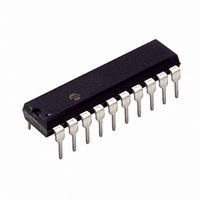PIC18LF13K22-I/P Microchip Technology, PIC18LF13K22-I/P Datasheet - Page 9

PIC18LF13K22-I/P
Manufacturer Part Number
PIC18LF13K22-I/P
Description
IC PIC MCU FLASH 256KX8 20-PDIP
Manufacturer
Microchip Technology
Series
PIC® XLP™ 18Fr
Datasheets
1.PIC18LF13K22-ISS.pdf
(388 pages)
2.PIC18LF13K22-ISS.pdf
(12 pages)
3.PIC18LF13K22-ISS.pdf
(36 pages)
4.PIC18LF14K22-IP.pdf
(382 pages)
Specifications of PIC18LF13K22-I/P
Program Memory Type
FLASH
Program Memory Size
8KB (4K x 16)
Package / Case
20-DIP (0.300", 7.62mm)
Core Processor
PIC
Core Size
8-Bit
Speed
64MHz
Connectivity
I²C, LIN, SPI, UART/USART
Peripherals
Brown-out Detect/Reset, POR, PWM, WDT
Number Of I /o
17
Eeprom Size
256 x 8
Ram Size
256 x 8
Voltage - Supply (vcc/vdd)
1.8 V ~ 3.6 V
Data Converters
A/D 12x10b
Oscillator Type
Internal
Operating Temperature
-40°C ~ 85°C
Processor Series
PIC18LF
Core
PIC
Data Bus Width
8 bit
Data Ram Size
256 B
Interface Type
I2C, MSSP, SPI, USART
Maximum Clock Frequency
32 KHz
Number Of Programmable I/os
18
Number Of Timers
4
Operating Supply Voltage
1.8 V to 3.6 V
Maximum Operating Temperature
+ 125 C
Mounting Style
Through Hole
3rd Party Development Tools
52715-96, 52716-328, 52717-734, 52712-325, EWPIC18
Development Tools By Supplier
PG164130, DV164035, DV244005, DV164005
Minimum Operating Temperature
- 40 C
On-chip Adc
10 bit, 12 Channel
Lead Free Status / RoHS Status
Lead free / RoHS Compliant
Lead Free Status / RoHS Status
Lead free / RoHS Compliant, Lead free / RoHS Compliant
- PIC18LF13K22-ISS PDF datasheet
- PIC18LF13K22-ISS PDF datasheet #2
- PIC18LF13K22-ISS PDF datasheet #3
- PIC18LF14K22-IP PDF datasheet #4
- Current page: 9 of 388
- Download datasheet (4Mb)
1.0
This family offers the advantages of all PIC18
microcontrollers
performance with the addition of high-endurance,
Flash program memory. On top of these features, the
PIC18F1XK22/LF1XK22 family introduces design
enhancements that make these microcontrollers a
logical choice for many high-performance, power
sensitive applications.
1.1
1.1.1
All of the devices in the PIC18F1XK22/LF1XK22 family
incorporate a range of features that can significantly
reduce power consumption during operation. Key
items include:
• Multiple Idle Modes: The controller can also run
• On-the-fly Mode Switching: The
• Low Consumption in Key Modules: The
2010 Microchip Technology Inc.
with its CPU core disabled but the peripherals still
active. In these states, power consumption can be
reduced even further, to as little as 4% of normal
operation requirements.
power-managed modes are invoked by user code
during operation, allowing the user to incorporate
power-saving ideas into their application’s
software design.
power requirements for both Timer1 and the
Watchdog Timer are minimized. See
Section 25.0 “Electrical Specifications”
for values.
DEVICE OVERVIEW
New Core Features
nanoWatt XLP TECHNOLOGY
–
namely,
high
computational
Preliminary
PIC18F1XK22/LF1XK22
1.1.2
All of the devices in the PIC18F1XK22/LF1XK22 family
offer ten different oscillator options, allowing users a
wide range of choices in developing application
hardware. These include:
• Four Crystal modes, using crystals or ceramic
• External Clock modes, offering the option of using
• External RC Oscillator modes with the same pin
• An internal oscillator block which contains a
• A Phase Lock Loop (PLL) frequency multiplier,
Besides its availability as a clock source, the internal
oscillator block provides a stable reference source that
gives the family additional features for robust
operation:
• Fail-Safe Clock Monitor: This option constantly
• Two-Speed Start-up: This option allows the
resonators
two pins (oscillator input and a divide-by-4 clock
output) or one pin (oscillator input, with the sec-
ond pin reassigned as general I/O)
options as the External Clock modes
16 MHz HFINTOSC oscillator and a 31 kHz
LFINTOSC oscillator which together provide 8
user selectable clock frequencies, from 31 kHz to
16 MHz. This option frees the two oscillator pins
for use as additional general purpose I/O.
available to both the high-speed crystal and inter-
nal oscillator modes, which allows clock speeds of
up to 64 MHz. Used with the internal oscillator, the
PLL gives users a complete selection of clock
speeds, from 31 kHz to 32 MHz – all without using
an external crystal or clock circuit.
monitors the main clock source against a refer-
ence signal provided by the LFINTOSC. If a clock
failure occurs, the controller is switched to the
internal oscillator block, allowing for continued
operation or a safe application shutdown.
internal oscillator to serve as the clock source
from Power-on Reset, or wake-up from Sleep
mode, until the primary clock source is available.
MULTIPLE OSCILLATOR OPTIONS
AND FEATURES
DS41365D-page 9
Related parts for PIC18LF13K22-I/P
Image
Part Number
Description
Manufacturer
Datasheet
Request
R

Part Number:
Description:
Manufacturer:
Microchip Technology Inc.
Datasheet:

Part Number:
Description:
Manufacturer:
Microchip Technology Inc.
Datasheet:

Part Number:
Description:
Manufacturer:
Microchip Technology Inc.
Datasheet:

Part Number:
Description:
Manufacturer:
Microchip Technology Inc.
Datasheet:

Part Number:
Description:
Manufacturer:
Microchip Technology Inc.
Datasheet:

Part Number:
Description:
Manufacturer:
Microchip Technology Inc.
Datasheet:

Part Number:
Description:
Manufacturer:
Microchip Technology Inc.
Datasheet:

Part Number:
Description:
Manufacturer:
Microchip Technology Inc.
Datasheet:










